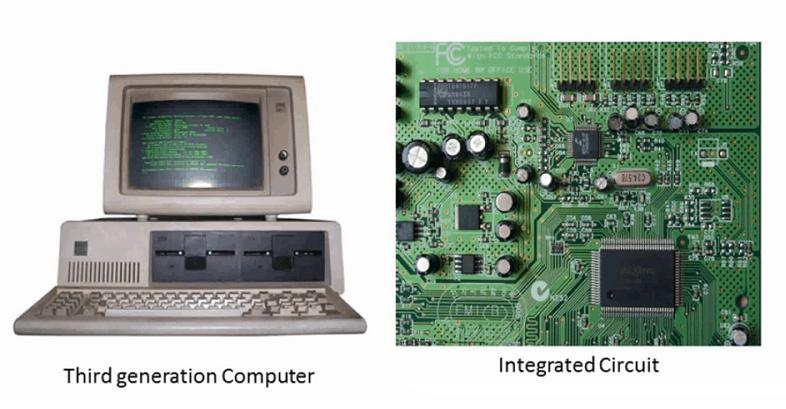Introduction
In1958,theengineerofTexasInstrumentsJackKilbyinventedtheintegratedcircuit(IC),combiningthreeelectroniccomponentsintoasmallsiliconchipsuperior.Morecomponentsareintegratedonasinglesemiconductorchip,andcomputersbecomesmaller,consumelesspower,andarefaster.Thedevelopmentofthisperiodalsoincludedtheuseofanoperatingsystem,whichallowedthecomputertorunmanydifferentprogramssimultaneouslyunderthecontrolandcoordinationofthecentralprogram.
Features
LSI(Large-ScaleIntegration)isusedtoformthemainfunctionalcomponentsofthecomputer,integratedcircuits(integratedhundredstothousandsoflogicgatesoneachchip)Itisalogiccircuitformedbyconcentratingmultipleelectroniccomponentsonasubstrateofafewsquaremillimeters.Thebasicelectroniccomponentsofthethird-generationcomputeraresmall-scaleintegratedcircuitswithseveraltoadozenelectroniccomponents(logicgates)integratedoneachsubstrateandmedium-scaleintegratedcircuitswithdozensofcomponentsoneachchip.
Thefurtherdevelopmentofcomputersoftwaretechnology,especiallythegradualmaturityoftheoperatingsystem,isasignificantfeatureofthethirdgenerationofcomputers.Thedevelopmentofmultiprocessors,virtualmemorysystems,anduser-orientedapplicationsoftwarehavegreatlyenrichedcomputersoftwareresources.Inordertomakefulluseoftheexistingsoftwareandsolvetheproblemofsoftwarecompatibility,aseriesofcomputershaveappeared.ThemostinfluentialistheIBM-360computerseriesdevelopedbyIBM.
Anotherfeatureofthisperiodistheapplicationofsmallcomputers.ThePDP-8,PDP-11seriesandlaterVAX-11seriesdevelopedbyDECCorporationhaveplayedagreatroleinthepromotionofcomputers.Itischaracterizedbytheuseoftransistorsinsteadofelectrontubes;alargenumberofmagneticcoresareusedasinternalmemory,andmagneticdisks,tapes,etc.areusedasexternalmemory;thesizeisreduced,thepowerconsumptionisreduced,thecalculationspeedisincreasedtohundredsofthousandsofbasiccalculationspersecond,andthememorycapacityisexpandedtoHundredsofthousandsofwords.
Whenthecomputerlanguagedevelopstothethirdgeneration,ithasenteredthe"human-oriented"languagestage.Thethird-generationlanguageisalsocalled"high-levellanguage".High-levellanguageisaprogramminglanguagethatisclosetopeople'shabits.ItallowstowritecalculationprogramsforsolvingproblemsinEnglish.Thearithmeticsymbolsandexpressionsusedintheprogramaresimilartothemathematicalformulasweusedaily.Thehigh-levellanguageiseasytolearnandhasstrongversatility.Thewrittenprogramisrelativelyshort,whichisconvenientforpromotionandcommunication.Itisanidealprogramminglanguage.High-levellanguagesdevelopedfromthemid-1950stothe1970s.Somepopularhigh-levellanguageshavebeenadoptedbymostcomputermanufacturersandaresolidifiedinthecomputer'smemory,suchastheBASIClanguage(nolessthan128differentBASIClanguageshavebeenpopular,ofcourseThebasiccharacteristicsarethesame).InadditiontotheBASIClanguage,therearemorethan250high-levellanguagessuchasFORTRAN(formulatranslation),COBOL(CommonBusinessLanguage),Clanguage,DL/Ilanguage,PASCAClanguage,andADAlanguage.
Компютърна история
Етап на развитие | Логически елемент | Основна памет | Скорост на изчисление (в секунди) | Софтуер | Приложение |
Първото поколение (1946-1958) | Електронна тръба td> | Electronicraytube | Хилядистотенсофтхилядимеки пъти | Машинен език,език за сглобяване | Военни изследвания,научни изчисления |
Второ поколение (1958-1964) | Транзистор | Ядро | Стотихиляди пъти | Програма за наблюдение, език на високо ниво | Обработка на данни,обработка на транзакции |
Третото поколение (1964-1971) | Малки интегрални схеми със среден размер | Полупроводник | Стотихилядистомилиони пъти | Операционна система,система за редактиране,приложна програма | Разработи много и започна да се използва широко td> |
Четвъртото поколение (1971-настояще) | Интегрирана схема LargescaleScale | Полупроводници с висока степен на интеграция | десетки милиони до стотици милиони пъти | Перфектна операционна система,система от бази данни,разработване на език на високо ниво,разработване на приложения | Проникнете във всички нива на обществото p> |
Първото поколение компютри с електронни тръби (1945-1956):
OnFebruary15,1946,ENIAC(ElectronicNumericalIntegratorandComputer)wasmadepublicinPhiladelphia.ENIACrepresentsamilestoneinthehistoryofcomputerdevelopment.Italsohasparallelcomputingcapabilitiesthroughrewiringprogrammingbetweendifferentparts.ENIACisjointlydevelopedbytheUSgovernmentandtheUniversityofPennsylvania.Ituses18,000tubes,70,000resistors,5millionsolderjoints,consumes160kilowattsofpower,andhasacalculationspeedof5,000operationspersecond.Thefirstgenerationofcomputersischaracterizedbyoperatinginstructionsthatareprogrammedforspecifictasks.Eachmachinehasitsowndifferentmachinelanguage,itsfunctionsarelimited,anditsspeedisslow.Anotherobviousfeatureistheuseofvacuumtubesanddrumstostoredata.
Транзисторен компютър от второ поколение (1956-1963):
Транзисторен компютър от второ поколение (2 снимки)
In1948,thetransistorTheinventionreplacesthebulkyelectronictube,andthevolumeofelectronicequipmentcontinuestodecrease.In1956,transistorswereusedincomputers,andtransistorsandmagneticcorememoryledtothesecondgenerationofcomputers.Thesecond-generationcomputersaresmallinsize,fast,lowpowerconsumption,andmorestableinperformance.In1960,thereweresomesecond-generationcomputersthatweresuccessfullyusedinbusiness,universities,andgovernmentdepartments.Second-generationcomputersusedtransistorsinsteadoftubes,andsomepartsofmoderncomputers:printers,tapes,disks,memory,operatingsystems,etc.Theprogramsstoredinthecomputermakethecomputeradaptableandcanbeusedmoreeffectivelyforcommercialpurposes.Duringthisperiod,moreadvancedlanguagessuchasCOBOLandFORTRANappearedtomakecomputerprogrammingeasier.Newprofessions(programmers,analystsandcomputersystemsexperts)andtheentiresoftwareindustrywereborn.Thefourth-generationlarge-scaleintegratedcircuitcomputer(1971-):
Компютър с широкомащабна интегрална схема от четвърто поколение (3 снимки)
(LSI)canholdhundredsofcomponentsononechip.Bythe1980s,verylargescaleintegratedcircuits(VLSI)containedhundredsofthousandsofcomponentsonachip,andlater(ULSI)expandedthenumbertothemillions.Theabilitytoaccommodatesuchanumberofcomponentsonacoin-sizedchipmakesthesizeandpriceofthecomputercontinuetodecline,whilethefunctionalityandreliabilitycontinuetoincrease.Inthemid-1970s,computermanufacturersbegantobringcomputerstoordinaryconsumers.Atthistime,minicomputerswereequippedwithsoftwarepackageswithfriendlyinterfaces,programsfornon-professionals,andthemostpopularwordprocessingandspreadsheetprograms.In1981,IBMintroducedpersonalcomputers(PCs)foruseinhomes,offices,andschools.Thecompetitionofpersonalcomputersinthe1980scausedpricestocontinuetofall,thenumberofmicrocomputerscontinuedtoincrease,andcomputerscontinuedtoshrinkinsize.TheAppleMacintoshseries,whichcompeteswiththeIBMPC,waslaunchedin1984.TheMacintoshprovidesafriendlygraphicalinterfacethatuserscaneasilyoperatewithamouse.Application
1.Numericalcalculation:ballistictrajectory,weatherforecast,highenergyphysics,etc.
2, управление на информацията: управление на предприятието, управление на материали, компютъризация и др.
p>3.Контрол на процеси:контрол на промишлена автоматизация,контрол на сателитна посока на полета
4. Спомагателно инженерство: компютърно подпомагано проектиране (CAD), компютърно подпомагано производство (CAM), компютърно подпомагано обучение (CAI), компютърно подпомагано тестване (CAT), компютърно подпомагано обучение (CAE), компютърно подпомагано публикуване (CAP) и др.

